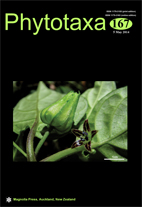Abstract
Three new species of Markea from Colombia are described and their morphological affinities and conservation status are discussed. Markea hunzikeri is different from other species of Markea because it presents a 3-lobed calyx and 3-lobed stigma. Markea huilensis shows affinity with Markea lopezii and Markea epifita, from which it differs by its exerted anthers, tubular-campanulate corolla and fruit with leathery, black, non-translucent exocarp when dry. Markea purpurea is clearly differentiated from other species in this genus by its very reduced, extra-axillary, short-pedunculate inflorescence, generally bearing one short-pedicellate or sessile flower with corolla dark purple or black inside. For new species illustrations, photographs of live plants and distribution maps are presented. As a tool for species identification of Markea, this paper is accompanied by a key to all species currently recognized in the genus. Additionally, photographs of live plants for most of the species of the genus are included.

